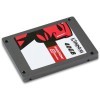- Qualcomm Launches Snapdragon 4 Gen 2 Mobile Platform
- AMD Launches Ryzen PRO 7000 Series Mobile & Desktop Platform
- Intel Launches Sleek Single-Slot Arc Pro A60 Workstation Graphics Card
- NVIDIA Announces Latest Ada Lovelace Additions: GeForce RTX 4060 Ti & RTX 4060
- Maxon Redshift With AMD Radeon GPU Rendering Support Now Available
Kingston SSDNow V Series 40GB

Want to make the upgrade to a solid-state drive, but prefer to avoid the high cost of adoption? Kingston helps ease that pain with its SSDNow V Series 40GB, a modest drive that features Intel’s NAND and impressive G2 firmware, which helps it deliver stellar performance when compared to an HDD, for an easy-to-stomach price.
Page 8 – Real-World: Windows Experience, Boot Times, Game Level Loading
Windows Experience
This is a test that any Windows 7 user can perform on their own system without needing to download anything. For those curious, Vista should allow the same, but we can’t guarantee the results will be directly comparable due to changes made in the WinSAT program. To run the program, hit the Windows Key + R at the same time, and type cmd into the run box. In the command prompt window type (or right-click and paste) the following without quotes: “cd c:windowssystem32” and hit enter. Once there input, again without quotes: “winsat disk -drive c -ran -write -count 10” and enter again.
This command runs a small portion of the Windows Experience Index’s drive assessment, specifically it uses small random writes and calculates how fast in MB/s the drive can sustain it. As we mentioned before with the HD Tune results, regardless of what drive is in question, its actual performance depends on what file size is being referred to. The smaller the file size generally the lower the performance for a hard disk drive, so again the small random file writes will be brutal.

Boot Time
For the boot test, we perform a cold boot, with the stopwatch starting the moment the power button is pressed until the last systray icon has finished loading. A large number of factors can change how fast a computer boots, from motherboard to just the BIOS configuration, so these times should not be used as an expectation of how fast the SSD will boot in your respective system. With some newer motherboards condensing the time taken in the boot process, boot times could reach significantly lower than these.

The Intel controller was heavily optimized for Windows startup, and those optimizations and quicker random small file reads/writes allows both drives to lead the Summit and cut as much as 18 seconds off the boot time versus the hard disk.
Game Level Loading
Crysis is still infamous for how well it could stress the entire PC, and although Crysis Warhead was a significant improvement and more optimized than it’s predecessor, it still makes for one of the better gaming benchmarks to use. For this test, we timed how long it took to load the first level, Ambush. We also figured we would use the newer Left 4 Dead 2 game, for its slightly longer-than-average load times. Here, we timed how long it took to load the final chapter in the Hard Rain campaign.

The results are fairly self-explanatory, but just to say it, level load times is one of those scenarios perfectly suited for an SSD. The best SSD was almost able to decrease the load times by half for each game, and keep in mind, this is the older first generation X25-M here.
Support our efforts! With ad revenue at an all-time low for written websites, we're relying more than ever on reader support to help us continue putting so much effort into this type of content. You can support us by becoming a Patron, or by using our Amazon shopping affiliate links listed through our articles. Thanks for your support!




